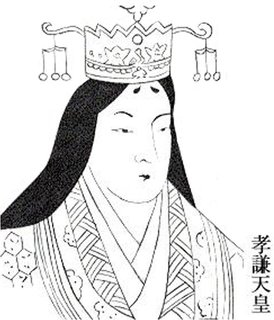Empress Kōken facts for kids
Quick facts for kids Empress Kōken / Empress Shōtoku孝謙天皇 / 称徳天皇 |
|||||
|---|---|---|---|---|---|
 |
|||||
| Empress of Japan (Kōken, first reign) |
|||||
| Reign | 749–758 | ||||
| Enthronement | August 19, 749 | ||||
| Predecessor | Shōmu | ||||
| Successor | Junnin | ||||
| (Shōtoku, second reign) | |||||
| Reign | 764–770 | ||||
| Enthronement | January 26, 765 | ||||
| Predecessor | Junnin | ||||
| Successor | Kōnin | ||||
| Born | Abe (阿倍) 713 |
||||
| Died | 28 August 770 (aged 56–57) | ||||
| Burial | Takano no misasagi (Nara) | ||||
|
|||||
| House | Yamato | ||||
| Father | Emperor Shōmu | ||||
| Mother | Empress Kōmyō | ||||
Empress Kōken (孝謙天皇 (Kōken-tennō)), also known as Empress Shōtoku (称徳天皇 (Shōtoku-tennō)), was a powerful female ruler in ancient Japan. She was the 46th and 48th monarch of Japan, according to the traditional list of emperors.
Empress Kōken ruled first from 749 to 758. Later, after a major event called the Fujiwara no Nakamaro Rebellion, she became empress again. Her second reign, as Empress Shōtoku, lasted from 765 until her death in 770. She was known for her close relationship with a Buddhist priest named Dōkyō. This relationship led to Dōkyō gaining much power. He even tried to become emperor himself, but her death and resistance from powerful families stopped his plans. This event was a big reason why the Japanese capital was later moved from Nara.
Empress Kōken/Shōtoku was the sixth of eight women who ruled Japan as empresses. Before her, five women had held the throne: Suiko, Kōgyoku/Saimei, Jitō, Genmei, and Genshō. After her, two more women became empresses: Meishō and Go-Sakuramachi.
Contents
Empress Kōken's Early Life
Empress Kōken's personal name was Abe (error: {{nihongo}}: Japanese or romaji text required (help)). Her father was Emperor Shōmu, and her mother was Empress Kōmyō. She was born in 713.
Her tomb is a special place called the Takano Imperial Mausoleum (高野陵 (Takano no Misasagi)). It is located in Nara, Nara, and people can visit it today.
Important Events in Kōken's Life
Here are some key moments from Empress Kōken's time as a ruler:
- August 19, 749: Her father, Emperor Shōmu, decided to step down from the throne. His daughter, Kōken, then became the new empress.
- 757: There was a plan to remove Empress Kōken from power, but it failed.
- 758: Kōken gave up her throne to her cousin, who became Emperor Junnin. She had ruled for about ten years.
- 764: Empress Kōken returned to power. She removed Emperor Junnin from the throne.
- January 26, 765: Kōken officially became empress again. This time, she was known as Empress Shōtoku.
- August 28, 770: Empress Shōtoku died at the age of 57. She had ruled for five more years during her second reign. After her death, her cousin, Emperor Kōnin, became the next ruler.
Eras During Her Reigns
The years of an emperor's or empress's reign in Japan are often named after different eras.
- During Kōken's first reign, the eras were:
- Tenpyō-kanpō (749)
- Tenpyō-shōhō (749–757)
- Tenpyō-hōji (757–765)
- During Shōtoku's second reign, the eras were:
- Tenpyō-hōji (757–765)
- Tenpyō-jingo (765–767)
- Jingo-keiun (767–770)
Empress Kōken's Legacy
Empress Kōken's time as ruler was quite challenging. She faced attempts to overthrow her government. She is most remembered for her close relationship with a Buddhist monk named Dōkyō. She gave him many important titles and a lot of power.
There was even a story that an oracle (a message from a god) from the Usa Shrine said Dōkyō should become emperor. However, when the empress sent a trusted person, Wake no Kiyomaro, to check this message, the god said that only someone from the imperial family should be emperor. This stopped Dōkyō's plan.
Because Empress Kōken and other female rulers were usually followed by male emperors, some historians believe that women's reigns were only temporary. They argue that the throne should always pass to a male heir. However, Empress Genmei was an exception, as her daughter, Empress Genshō, became empress after her.
Empress Kōken also supported a huge project called the Hyakumantō Darani. This was one of the largest productions of printed works in early Japan. It involved printing millions of small wooden pagodas, each containing a Buddhist prayer scroll.
She also founded Otagi Nenbutsu-ji, a Buddhist temple in Kyoto. This temple was built in the middle of the eighth century.
Kugyō: Powerful Court Officials
The Kugyō (error: {{nihongo}}: Japanese or romaji text required (help)) was a special group of very powerful men in the Japanese court. They were the most important advisors to the emperor or empress. This group usually had only three or four members at a time. These men came from important families and had a lot of experience in government. They reached the highest levels of their careers.
During Empress Kōken's and Empress Shōtoku's reigns, some of these important officials included:
- Emi no Oshikatsu (also known as Fujiwara no Nakamaro)
- Tachibana no Moroe
- Fujiwara no Toyonari
- Kibi Makibi
- Dōkyō (during Shōtoku's reign)
See also
 In Spanish: Kōken Tennō para niños
In Spanish: Kōken Tennō para niños

